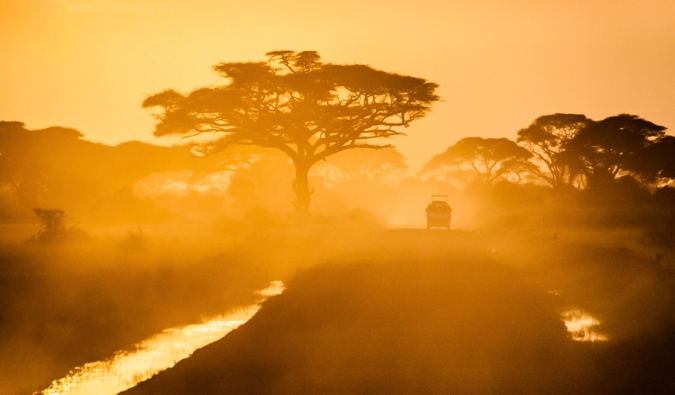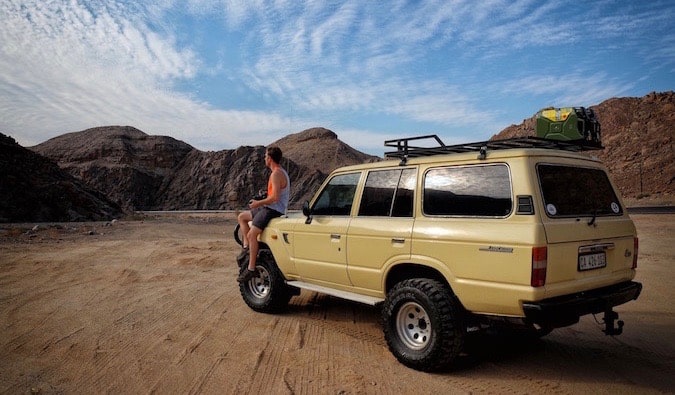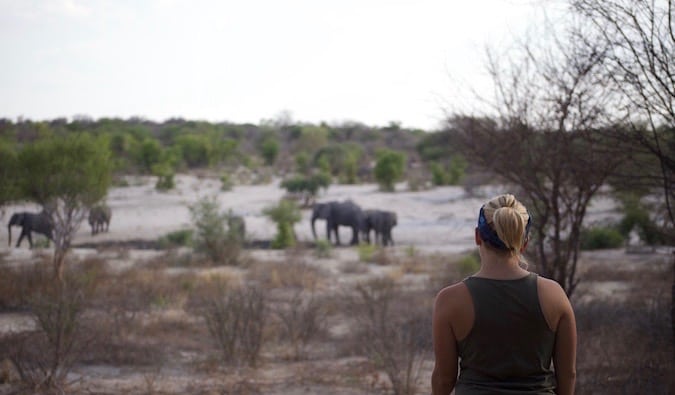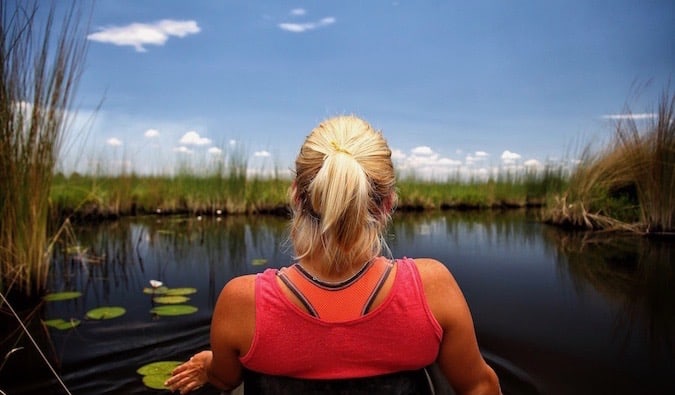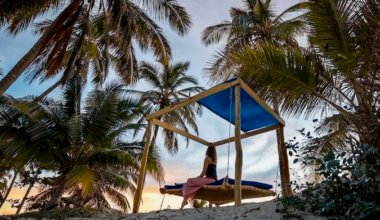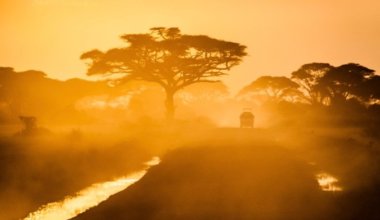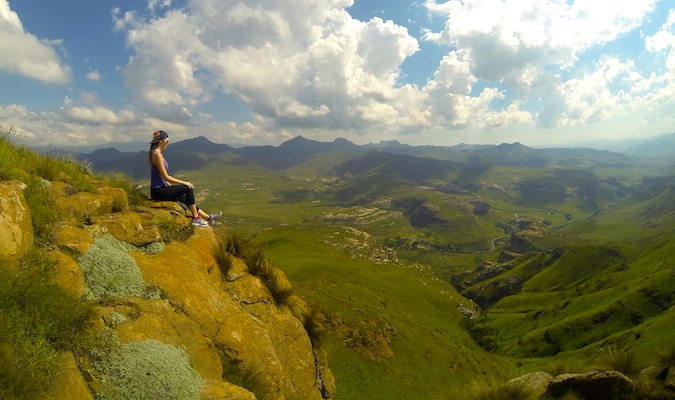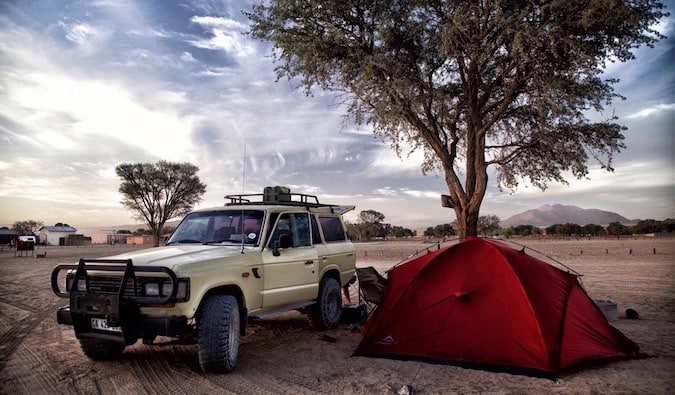
Last Updated: 2/6/23 | February 6th, 2023
This post is by Natasha and Cameron from The World Pursuit. While I’ve been to Africa in the past, I’ve only seen a few countries and this website is really thin on Africa content. I’m super excited to have these two travelers share their knowledge about traveling the continent. Today, they share their tips and tricks on how to get around Southern Africa on a budget.
In 2016, we started thinking about our trip through Southern Africa. We knew that the region was vast and that travel there was a difficult mystery. We weren’t even sure if it was possible to cross the continent on our own. All we knew was that we wanted to see the great African plains, watch lions attack impalas, and have a drink while listening to the sound of fish eagles.
Fast forward nine months, and we now own a South African–registered Land Cruiser and have been touring the massive continent by ourselves.
How did we get to this point? Was it the cheapest option? Or did we make a massive blunder by throwing a bunch of cash into a major liability, what with bad roads, border officials, bribes, and mechanical costs?
Perhaps an overland tour would have been the best option? Or might backpacking across the continent have achieved our goal?
What is the best option for budget travelers in Southern Africa: an overland tour, backpacking, or self-driving? It all comes down to what you want to see and how you want to experience Africa.
Here are the pros and cons of each option:
Overland Tours
Overland tours are one of the most popular options for young people wanting to travel Southern Africa. All transportation and accommodation, most food, and many activities are covered. They require little to no planning and no driving, are safe, and offer a sure way to meet other travelers.
Intrepid Travel, Acacia Africa, Nomad, Oasis, and Absolute Africa are five of the most popular “budget” overland safari companies. These tours venture in and around South Africa, Namibia, Botswana, Zimbabwe, Zambia, and Malawi (as well as Rwanda, Uganda, Kenya, and Tanzania).
Some tours cut out a few countries, while the “mega” tours include all of them. Some of the tours spend only two days in a certain country; others may spend a week there.
Additionally, some tours include almost all activities, food, and park fees in the cost while others make these add-on fees. There are also other add-ons you can include such as bungee jumping off the Victoria Falls Bridge or a hot-air balloon ride over the Serengeti.
Regardless of the overland company, expect to add roughly $5-15 USD a day for various expenses, like water, beer, and tipping your guides. Generally speaking, the longer the tour, the cheaper the per-day cost is.
Here is a quick price comparison:
| Tour Company | Average Daily Cost |
| Acacia | $145 USD |
| Nomad | $160 USD |
| Oasis | $88 USD |
| Absolute | $115 USD |
| Intrepid | $131 USD |
Just keep in mind that the prices differ according to where in Africa you are traveling. This is a crucial detail when determining whether to take an overland tour or go at it alone.
Southern Africa is intrinsically cheaper and easier to do on your own than the rest of Africa. I like to call it “Africa Light.” Gas is cheaper, national parks are cheaper, food is cheaper, and the infrastructure is better suited for tourism. A tour in Southern Africa won’t be the same price as a tour in East, West, or North Africa. Every region costs different; Africa is far from uniform!
Pros of Doing an Overland Tour in Southern Africa:
- Organized tours require little to no planning on a challenging continent
- Great option for meeting people, especially as a solo traveler
- Knowledgeable guides and safe drivers navigate harsh road conditions
- Groups can be great fun
Cons of Doing an Overland Tour in Southern Africa:
- Lack of “adventure” on an organized tour
- No independence and hard to get away from the typical tourist activities
- Lack of genuine local interaction
- High cost
- Enjoyment is subject to the atmosphere of the group
Additionally, there are a few experiences offered by some overland tours that we do not agree with ethically. Any tour that puts you in direct contact with wild animals, such as lion walks, cheetah petting, and elephant riding, should raise immediate red flags.
Ethics and tourism in Africa can be very murky; don’t always expect your tour operator to vet every activity and attraction. For more information about ethical animal tourism, read this post.
Self-Driving
There are a plethora of variables that go into self-driving, but we’ll stick with the basics. Operating on the assumption that you will not choose to purchase a vehicle in Africa (you’d have to be crazy like us), your four main expenses will be transportation, food, accommodation, and activities.
Transportation
When we first arrived in South Africa, we got a small pickup rental truck for $650 USD per month ($21 USD a day), split between the two of us. We went with a 2×4 to travel through Mozambique, but if you route carefully and skip the dirt roads and sand, it’s very possible to get around most of southern Africa in a sedan (we’ve even met people doing it on motorcycles)!
Rental vehicles are the cheapest in South Africa and can be driven into neighboring countries with a letter from the rental company stating your intent to cross borders. Price has gone up since our trip, so currently, a manual sedan in Johannesburg can be rented for as little as $150 USD per week.
You may want to drive to remote areas, which means you need a fully kitted 4×4 rental; those come in at $675-1,000 USD a week out of South Africa and Namibia on the low end for a round-trip car rental.
However, for that price, you can score a truck that can go anywhere and has comfortable roof tents that can accommodate four people — which is the best way to get one heck of a safari for an affordable price. (We self-drove into the Okavango Delta and got further than any backpacker or overland tour could ever go.)
It’s important to factor road tolls and gas into your costs. Tolls in southern Africa are few and far between, but they do exist and you can expect to pay $10–20 USD a week in tolls if you’re driving around South Africa. For example, Cape Town to Johannesburg costs around $12 USD in tolls while Johannesburg to Durban costs around $18 USD.
Keep in mind that distances are vast in Africa, so you’ll be covering some major ground getting from point to point. Southern Africa is bigger than all of Europe, so expect to budget about $150–225 USD a week for fuel, depending on how fast you move and the distances covered. Gas prices fluctuate widely so check prices beforehand to better estimate your expenses.
While these numbers may be difficult for a solo traveler, a group of friends together can make an African road trip very cheap. Obviously, the cost per person goes down with the more travel companions you add. If you don’t have travel partners, try joining groups on Facebook like Backpacking Africa.
Food
Food in Africa can be very affordable (of course there are some exceptions to this if you are eating out or have a special diet). You can find almost everything you want at large Western supermarkets in South Africa; however, as you work your way north, Western-style grocery stores become a rarity.
Outside of big cities, most food will come from roadside stands or tiny convenience stores — all of which offer affordable local prices. If you’re cooking your own meals, you can get by on less than $80 USD a week for food. That includes eating three meals a day and items that may be considered luxuries to backpackers, such as steak, real coffee with milk, and a decent sandwich lunch.
Accommodation
Campsites can range from $10–20 USD per person a campsite; this does not include a tent or sleeping bag. Camping in southern African national parks is closer to $20–30 USD per person plus daily park fees. The campsites are usually fenced in to provide protection from wildlife and have facilities such as an ablution block.
In major cities, you will be able to find hostels, budget hotels, and Airbnbs, and it’s possible to get a bed for the same price as camping. Dorm beds run $12–20 USD per night and a double room $20–50 USD per night (depending on how fancy you want to get).
Keep in mind, however, that this isn’t Europe. Don’t be picky and prepare for some less-than-desirable rooms.
If you’re feeling truly adventurous, rooms in local roadside establishments cost around $3–10 USD a night but don’t plan on sleeping much because they’re often noisy and a little dirty.
Activities
You can’t get around Africa without some activity expenses. National parks, private game reserves, and safaris all cost money (as do other activities like bungee jumping, hot air balloon rides, and any other adventure activities).
The good news is that park costs in the region are all affordable. Although you won’t have the comfort of being in a big game viewer and will have to spend money on fuel driving around the park all day, you will still be able to see wildlife driving your own vehicle on your own time. Prices for parks vary but expect to pay between $10-25 USD for admission.
Note: These entry fees are based on international passports and do not include vehicle fees. Almost every park in Africa charges a vehicle fee for self-drivers. The fee can range anywhere between $5-50 USD per day, depending on the country and the car’s type and registration (though most fees are under $10 USD). In summary, it is next to impossible to estimate a budget for driving yourself.
Here are some average self-driving costs per day per person:
| Rental car and fuel (two persons)* | $33 USD (sedan) to $95 USD (4×4) |
| Accommodation | $5-10 USD (camping) to $13-25 USD (dorm or shared private room) |
| Food | $10–15 USD |
| Activities | $10 USD |
| Total | $55–150 USD |
Prices based on car rentals in South Africa.
Pros of Self-Driving Southern Africa:
- Sense of adventure tackling Southern Africa on your own
- Freedom to drive wherever you want
- National parks are cheaper than hopping on an organized safari
- You can take as much or as little time in a place
- You can delve deeper into local and rural African life with your own set of wheels
Cons of Self-Driving Southern Africa:
- The paperwork and bureaucratic headache of crossing borders with a car
- Constant planning and routing and always being “on” can become exhausting
- Maintaining and fixing the car if anything goes wrong
- Little to no help if problems arise
- Poor road maintenance can lead to potholes and road corrugation
Public Transport or “Backpacking”
It is incredibly hard to estimate the cost of backpacking around Southern Africa because it can vary so widely depending on one’s style. It’s also dependent on if you want to completely go off the grid or if you want to do touristy things.
Some may be okay with walking into a village, paying a few dollars to the local chief, and pitching a tent in the dirt, while others wouldn’t dream of this and would rather take public transport from campsite to campsite.
Living like a local in Southern Africa is very hard if you’re traveling. Poverty is rampant in Africa, and many Africans can’t even afford to adequately feed themselves, let alone travel to the next town while living on a dollar a day.
Due to the lack of demand and infrastructure for long-distance travel, transport options are much more difficult compared to the West and Asia.
Transportation
Local buses around town can cost anywhere from $0.25-1.50 USD. They also only serve local towns and villages. For the larger intercity buses, you can expect to pay $10–25 USD for a 4–12-hour bus ride (sometimes longer). Tourist spots, parks, hostels, and campsites are often not near any major towns or villages, so you’ll need some budget for local taxis or plan on hitchhiking. The price of a taxi can range from $3–15 USD, depending on distance and remoteness.
Food
There shouldn’t be any difference here compared to self-driving. The only exception is that self-drivers have the advantage of buying items in bulk and carrying cooking gear with them. If you are traveling by local transport and backpacking, your food options may be cheaper as you eat more and more of the local food and have less access to supermarkets.
On the other hand, your costs could rise since you may not have the proper gear to cook all your own meals and may, therefore, frequent restaurants more.
Accommodation
Campsites, hostels, and guesthouses will not differ in pricing compared to those for self-drivers. However, as an overland traveler without a car and just a backpack, you can sometimes instead pay a small fee ($3–5 USD) to a local village chief and pitch a tent in the community.
Activities
While you’ll be able to save on most things when backpacking in southern Africa, you will lose out when it comes to seeing wildlife. Whereas overland tours and self-drivers have their own vehicle, backpackers have to pay for each and every safari experience they want to have. Hopping on a day game drive into game parks costs between $40-250 USD.
The price difference is large when compared to self-driving with your own vehicle, but most backpackers visit fewer parks so the cost difference isn’t out of this world. South Africa does have an All Parks Cluster pass for around $50 USD.
These are some average backpacking costs per day:
| Transportation | $10-15 USD |
| Accommodation | $10-25 USD |
| Food | $10-15 USD |
| Activities | $15 USD |
| Total | $45-70 USD |
It is possible to backpack Africa for cheaper; we’ve even met people walking, backpacking, or cycling around the continent. However, someone who travels slowly, camps in villages, and skips national parks will have a much different trip than overland tours and self-drivers in southern Africa.
Pros of Backpacking Southern Africa:
- Complete integration into local life
- Cheaper than a tour or self-driving
- Breaks boundaries with locals as they do not view you as having many means
- Operate on your own schedule
Cons of Backpacking Southern Africa:
- Uncomfortable, exhausting, long, and even dangerous bus and train rides across the continent
- Greater chance of getting in an accident or having items stolen
- You should get used to being dirty
- No one to help you should something go wrong
- Constant routing and planning can get tiring
Final Verdict
So, what’s the best option for seeing southern Africa? It’s a difficult decision because overland tours are certainly the easiest, but also the most expensive and least adventurous.
Backpacking can be difficult and uncomfortable and may hinder your experiences in Africa as most of the natural sights and national parks are far removed from populated cities where public transport operates. However, if you’re looking to meet some of the friendliest people on earth Africans are quick to befriend a backpacker.
Self-driving falls somewhere in the middle, as it can be incredibly adventurous but will offer the most flexibility with a more mid-range price tag.
In my opinion, Southern Africa is best done on your own because of its infrastructure and lower cost. Traveling through each country varies a lot. In the end, it comes down to what you are looking for in terms of adventure, interactions, costs, comfort, and ease.
But no matter what you choose, you’re sure to have an amazing experience!
Natasha and Cameron run the blog The World Pursuit, focusing on adventure and cultural travel. They met in the film industry before deciding to abandon the American lifestyle and travel the world together. You can follow along with their adventures on Instagram and Facebook.
Book Your Trip: Logistical Tips and Tricks
Book Your Flight
Use Skyscanner to find a cheap flight. They are my favorite search engine because they search websites and airlines around the globe so you always know no stone is left unturned.
Book Your Accommodation
You can book your hostel with Hostelworld as they have the biggest inventory and best deals. If you want to stay somewhere other than a hostel, use Booking.com as they consistently return the cheapest rates for guesthouses and cheap hotels.
Don’t Forget Travel Insurance
Travel insurance will protect you against illness, injury, theft, and cancellations. It’s comprehensive protection in case anything goes wrong. I never go on a trip without it as I’ve had to use it many times in the past. My favorite companies that offer the best service and value are:
- Safety Wing (for everyone below 70)
- Insure My Trip (for those over 70)
- Medjet (for additional repatriation coverage)
Looking for the Best Companies to Save Money With?
Check out my resource page for the best companies to use when you travel. I list all the ones I use to save money when I’m on the road. They will save you money when you travel too.
